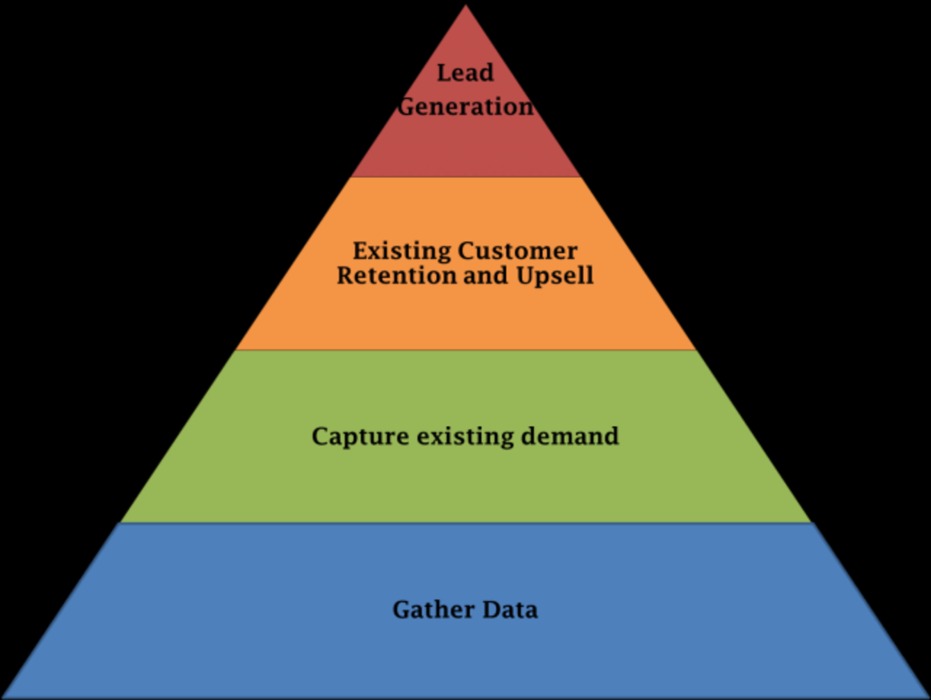Leads, leads, and more leads—it’s a refrain we hear daily from our existing and prospective national brand clients: “We need to deliver leads to our affiliates (distributors, dealers, agents, reps, franchisees) in order to deliver value.” When done properly, this refrain does indeed deliver value, but it ignores one simple fact:
Lead generation sits at the top of the marketing hierarchy and without creating a stable foundation the brand is actually ignoring a far more powerful approach to delivering value.
Many national brands jump directly to demand generation activities when engaging in local marketing, in particular to capture new audiences. However, lack of demand is typically not the issue—the issue is capturing the customers who are already looking for the brand’s products in the local marketplace but are instead buying from a competitor. National brands should first help their affiliates capture current demand and nurture existing customers. Simultaneously, they should build the infrastructure needed to scale local efforts across multiple markets and give them access to aggregated tracking.
Only then should investments be made for capturing new audience demand.
Effective local marketing consists of a hierarchy of strategic initiatives that all result in either driving or retaining revenue at the local and the national level. These four initiatives can be illustrated as a pyramid with a strong foundation being critical to the success of any of the initiatives above. Here is a simple diagram of this methodology:
As you can see, leads are—and should be—at the top of the pyramid. This is because in today’s socially connected, digitally informed, highly fragmented marketing landscape brands can no longer abdicate the blocking and tackling elements of local marketing to their affiliates.
In the past, brands could provide assets to their affiliates (yellow page templates, newspaper ads, brochures, etc.) and have confidence that their affiliates would responsibly and reliably utilize those templates to capture existing demand in the marketplace. The concentrated nature of the consumer marketplace made this assumption both valid and profitable.
Fast forward to today’s environment
Today, simply being found by a potential customer looking for your service or product presents a significant challenge for the local marketer. Even aside from a search engine-optimized local website, just trying to get a Google+ page listing optimized to show up above a competitor (this is basic blocking and tackling) requires much more time than placing an ad in the yellow pages ever did. Now, factor in the aforementioned SEO, a mobile-enabled website with full analytics and phone tracking, plus a well-run SEM campaign and you can quickly see that an unsophisticated local marketer is going to struggle to simply make it to the second level of the pyramid.
Once the consumer (or business) searching for your affiliate becomes a customer, retention or upselling is now equally difficult. The availability of reviews and the continual bombardment of rival solutions have resulted in a lack of loyalty and an increasingly competitive landscape.
Finally, once the affiliate has built a strong foundation for being found and is effectively retaining and upselling its existing customer base, then and only then should the brands be facilitating demand generation activities. Unfortunately, far too many brands are focused on driving demand into an unstable foundation, resulting in both customer and affiliate frustration and a massively expensive program destined to fail.
Now, for the good news
Marketing channels exist today that are highly scalable and, with the right technology, they can be automated. This presents brands with the capability to not only assist their affiliates in a way that is desperately needed, but to also provide national brand level strategy and execution to their local affiliates. In doing this the brand can not only get the affiliate on the pyramid, but can also ensure their affiliates are executing at a high level.
If you are responsible for a brand that relies on local affiliates for marketing, sales, or delivery of your product or service, make this the year you resolve to stop chasing leads and start building a stable pyramid.
Pete Gombert is CEO of Balihoo, a provider of local marketing automation technology and solutions for national brands.








